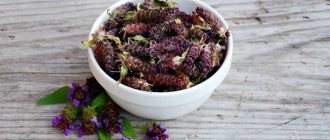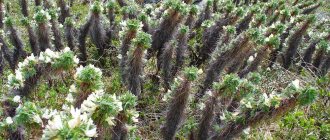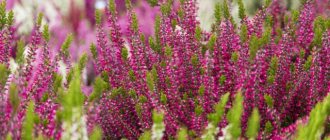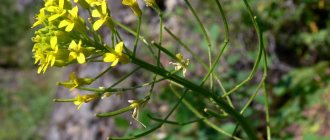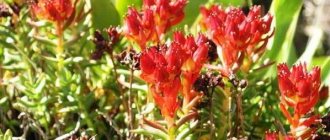The three-leaf plant is a widespread, herbaceous plant, a frequent inhabitant of swampy areas. Belongs to the genus Menyanthes of the family Menyanthaceae.
As a medicinal plant, Vacht trifolia has been known since ancient times. It is currently recognized as official medicine, although its use is not as widespread as among the people. Plant preparations are prescribed mainly for various functional disorders of the gastrointestinal tract and diseases associated with them, and also as a choleretic agent.
The beneficial and medicinal properties of the three-leaf plant are recognized in folk medicine in many countries. Its application is quite wide, from respiratory diseases to the skin. The watch herb has been used as a tonic.
The plant is effective both for self-administration and is included in various collections with other medicinal plants.
The use of the three-leaf watch has also been used for food purposes. The powder of crushed leaves is used as a spice similar to black pepper for medicinal purposes. The consumption rate is up to 2 grams. per day.
In brewing, the leaves of the trifolium are used to give beer a pleasant velvety taste.
Honey plant.
Types and varieties
The watch genus is monotypic and consists of only one species - three-leaf watch.
Three-leaf watch. Latin name : Menyanthes trifoliata L.
Three-leaf watch. Other names : trefoil watch, water trefoil, trefoil, trefoil, watch-grass, female toadgrass, toad cucumbers, diarrhea grass, scrofulous grass, consumptive grass, wolf cabbage, womanizer, toothgrass, fever grass, river lapushnik, trefoil, etc.
Botanical description
Wachta trifolia is a herbaceous perennial. Height: 15-40, up to 60 cm.
- The rhizome of the three-leaf plant is thick, long, spongy, creeping, knotty, and has noticeable scars in places where fallen leaves have fallen. Sparse roots emerge from the nodes.
The end of the rhizome is slightly raised and 3-5 stems with rosettes of leaves and a flower shoot grow from each tip of the rhizome shoot.
- The leaves of Trefolia are alternate, large, compound, trifoliate, expanding in the lower part into the sheath. They are located on long petioles.
The leaves are oblong-obovate, obtuse, most often entire, glabrous. Almost sessile or have a very short petiole. Colour: bluish green.
The taste of the leaves is bitter, the smell is almond.
- The flower stem of watch trifoliate is upright, leafless.
- The flowers are regular, funnel-shaped, naked on the outside, fringed-ciliated on the inside, cut into five lanceolate pointed lobes. There are five stamens, a pistil with a bilobed stigma and an upper ovary. Color: pale pink. Collected at the top of the stem into an oblong dense raceme-inflorescence.
- The fruit is a round, multi-seeded, two-leaf capsule. The seeds of Trefolia are large, elliptical, compressed on both sides, shiny.
- Flowering period of the three-leaf watch: May – July. The fruits ripen in July-August.
- Propagated by seeds and rhizomes.
Botanical characteristics
The three-leaf plant has a long, thick and creeping rhizome. Inside it is permeated with air-bearing cavities. From each apex of the rhizome shoot, 3–5 stems are formed, the height of which is about 30 cm. Large trifoliate leaves on long petioles are elongated and widened at the base. They are quite juicy, bright green in color. The flowering stem, which can reach 40 cm in length, has no leaves. At its end there is a racemose inflorescence consisting of pale pink flowers with a funnel-shaped corolla of five lobes, each of which is covered from the inside with velvety pubescence. The flowering period lasts from May to June. Then, towards the end of summer, fruits appear - pointed, bivalve capsules with seeds.
Habitat
The three-leaf plant is widespread in the temperate regions of the Northern Hemisphere: North America, Europe and Asia, up to the subtropics. In the CIS countries - this is the European part, Ukraine, Western and Eastern Siberia (with the exception of the south), and the Far East.
Vahta trifolia grows on wet, marshy banks of reservoirs (rivers, lakes, ponds), marshy meadows, and swamps, including peat, sphagnum and moss, near ditches. Can grow in water.
Sometimes it forms vast, dense thickets that stretch for several hectares.
Prefers peaty and mineral soils.
About the plant
Three-leaf watch is a medicinal plant whose inflorescences are quite large.
They can be easily seen at night. Thanks to this, the people called the water trefoil the watch, which, as if standing guard, warns anyone that he is approaching the water. Describing the plant we can say the following:
Trifoli leaves, as the watch is called in medicine, is a herbaceous perennial.
- The root is a creeping long and thick rhizome, reaching a length of up to one meter;
- The leaf is simple trifoliate consisting of segments of epileptic shape. The color is green in dark tones. Long-petiolate;
- The flowering stem does not have leaves, usually more than half a meter in length;
- The inflorescence consists of a multi-flowered raceme of oblong shape;
- A flower with funnel-shaped fused fringed petals, divided into five parts of a soft pink or white color.
- In the form of a fruit, a seed capsule with two valves is formed, which can be called ovoid. It is smooth to the touch and contains many seeds. The length of the box does not reach a millimeter.
- The ellipse-shaped seed, no more than three millimeters long, is smooth and shiny. Color from yellow to brown.
- The watch flowering occurs at the end of spring and beginning of summer. By August, fruits with ripened seeds are formed.
- Reproduction is predominantly vegetative and only occasionally does a plant increase its population by using seeds or root parts.
Spreading
The plant can be found in the temperate climate zone of the northern hemisphere, where there are marshy areas. The watch also lives in many ponds, on the banks of rivers near the water itself, in backwaters and standing waters, and peat deposits. Its growth area is quite extensive: it can be found in forest zones where there are swampy meadows in Europe, the Far East, and Siberia, both Western and Eastern. Trifol is also found in North America.
Compound
A number of bitter glycosides and at least three percent tannins were found in the composition of the leaves of the three-leaf plant. Trifoli foliage is also rich in fatty acids and oils, choline, resin acids and iodine-containing substances. In addition to glycosides, the rhizome of the plant contains inulin, pectins and tannins.
Collection and preparation
For medicinal purposes, the leaves and, less commonly, the roots of the three-leaf plant are harvested. The leaves are collected after flowering - the second half of June - August. Leaves collected earlier than this period are more juicy and darken when dried, which is a sign of deterioration in the quality of the raw material. When harvesting the three-leaved plant at a later date, brown spots often appear on the leaves.
Only well-developed leaves are suitable for collection, which are torn off with a short, no more than 3 cm remaining petiole. Young and apical leaves are not suitable for harvesting.
It is unacceptable to pull out plants by the roots, as this leads to the death of the thickets. Re-collection of three-leaf watch in this area can be carried out after 2-3 years.
When drying, it is important that the raw materials (leaves of the three-leaf plant) remain green. Since the collected leaves are usually wet, they are initially dried in the open air, in the shade, with good air ventilation, spread in a thin (1-5 cm) layer, not forgetting to turn them over often. Drying should be done either in special dryers or in a room that must be well ventilated.
The finished dried raw materials of the three-leaf watch are stored in bags and boxes made of natural materials in a dry, cool, well-ventilated area. Shelf life – 2 years.
Preparation and storage
The leaves of this plant are used in medicine for medicinal purposes. They are usually harvested after flowering, when they are in the full development phase (apical and young ones are not suitable for drying). The leaves are cut together with the petiole so that the length of the latter does not exceed 3 cm. In order to prepare three-leaf watch, pickers are forced to go into the water or use a boat, so it is preferable to do this in warm weather.
The collected leaves are laid out in the open air and dried to remove residual water. After this, for further drying, they are laid out in a dark, well-ventilated place. You can use a special dryer for this purpose - in this case, the color and shape of the leaf blades are very well preserved. The degree of readiness is determined by the bending method. If the remainder of the petiole and veins break easily and do not bend, the drying process can be considered complete. The product yield is 16–18%. Finished raw materials are packaged and stored for two years. Repeated harvesting of plants in the same place is carried out no earlier than after 3 years.
Chemical composition
The beneficial and medicinal properties are determined by the components in the chemical composition of the three-leaf watch. Fatty oil was found in the leaves, which contains fatty acids (oleanolic, palmitic, linoleic, etc.), vitamin C, etc.
In addition, the leaves contain bitter glycosides (meniantin, melantin, loganin, sveroside), flavonoids (rutin, hyperoside, etc.), the alkaloid gentianin, tannins (up to 3-7%), as well as substances containing iodine and choline. Macro- and microelements are represented by the following: potassium (15.5 mg/g), calcium (6.5 mg/g), as well as manganese (218 µg/g), boron (96 µg/g), aluminum (57.68 µg/g), zinc (33.1 µg/g), copper (5.33 µg/g), etc.
The roots of the three-leaf plant contain saponins, alkaloids, the glycoside melantin, inulin, betulinic acid, tannins and pectin substances, etc.
Important! The information presented in the material is for informational purposes only. Before use, be sure to consult a specialist.
You can also make kvass
Fans of eco-drinks with an exotic taste can prepare kvass based on trefoil. To do this, take freshly picked leaves, wash, chop and boil for 10 minutes. Sugar and dry yeast are added to the cooled broth. After 12 hours, the refreshing drink is ready. The proportions of the ingredients are as follows: for 1 liter of water, 50 grams of leaves, 70 grams of sugar and 1.5 grams of yeast.
Vakhtovaya officinalis (trifol) is a herbaceous perennial plant that belongs to the Vakhtov family. In various names of the trefoil, the words “watch” and “water” are found, and this is no coincidence, since growing in the vicinity of bodies of water, it seems to be on watch - brightly visible flowers in the dark warn travelers about the danger in the form of water. Names such as consumptive and feverish have become established in some areas, due to the scope of their use in the treatment of diseases of the same name since ancient times. The therapeutic effect when using a medicinal plant is achieved primarily due to the bitter glycosides and flavonoids it contains.
The description of the medicinal plant trefoil (watch, tripol) is as follows. It has a thick, long and creeping rhizome; it rises upward. The trifoliate leaves originate from the rhizome itself; long petioles sometimes reach 30 cm. The dark green leaves are grouped in threes, which is also reflected in the name of the plant. This grouping of them resembles the design feature of clover leaves, which can also be called a trefoil.
Large inflorescences are located on a separate bare stem-arrow and look like oblong brushes up to 7 cm in size. Five-pointed flowers, similar to stars, have a regular geometric shape. Sometimes flowers have six petals. Their color is white or pale pink. There are five stamens in the center. The fruits appear by the end of summer in the form of spherical single-locular boxes with a diameter of about 8 cm. It contains 6–8 brownish seeds up to 3 cm in size. The herb has no smell, but has a very bitter taste.
The area where water trefoil grows is the European part of Russia, Siberia and the Far East. The plant is not found in Central Asia and Crimea. Usually, cinquefoil and whitewing grow near the watch on the shores of lakes and swamps. Together they are intertwined with rhizomes and form a mesh surface on the reservoir in the form of thickets, on which sedge, horsetail and mosses subsequently settle.
Trifoli blooms in the first two months of summer. During this period it is prepared. It is necessary to cut with petioles, but no more than 3 cm. To prevent bitter glycosides from losing their medicinal properties, the collection should be dried as quickly as possible. Lay out the grass in a thin layer. If there are no suitable conditions for natural drying, artificial ovens are used, which create a temperature of about 50 °C. Pack dry grass in boxes or fabric bags, after removing all blackened leaves. Properly prepared raw materials can be stored for two years.
Read also: If you crush a bug, will there be blood?
You can grow trefoil at home, but such a plant is called oxalis. At the same time, the indoor plant has the same healing properties, and growing it is not at all difficult. To do this, you will need very moist soil, similar in composition to swamp soil.
The plant owes its therapeutic effect on the body to its chemical composition. The main active ingredients contained in the leaves are bitter glycosides and tannins. The grass also contains a sufficient amount of fatty oils and acids, iodine. The roots contain inulin and tannins.
Preparations made from trifoli are used to have the following effects on the body:
- choleretic;
- anti-inflammatory;
- mild laxative;
- sedative;
- antiseptic.
The range of uses of trefoil for medicinal purposes is wide. Preparations using it help fight pulmonary tuberculosis, cough and catarrhal sore throat. They use a watch against periodontal disease, stomatitis and trophic ulcers. Used to treat liver diseases, constipation and to eliminate hemorrhoidal bleeding. For anorexia, if its origin is associated with a functional disorder, shamrock also helps. Medicines from it are also prescribed to enhance the secretion of the glands of the gastrointestinal tract.
Indications for the use of leaves of the three-leaf plant also include its antipyretic effect. Antiseptic properties are widely used in folk medicine to disinfect purulent wounds and speed up the healing process. For scrofula in children, decoctions for baths are prepared from raw materials. Infusions are taken orally for treatment:
- anemia;
- rheumatism;
- skin diseases.
The bitterness contained in the herb improves digestion, reduces the concentration of gases in the intestines, has a beneficial effect on gastritis with low acidity, and helps increase appetite.
The products can be prepared either from preparations purchased at a pharmacy or prepared independently. At home, use the following recipes:
- To prepare a decoction for oral administration, take water (a glass) and herbal leaves (a tablespoon). You need to boil for five minutes, then let it brew for about two hours and filter. The daily intake is three tablespoons. Take one before each meal. Recommended for digestive problems and liver diseases. The product is useful for relieving swelling caused by heart problems.
- To prepare an infusion for external purposes, the infusion does not need to be boiled. It is enough to brew two tablespoons of raw material with a glass of boiling water and let it brew for 40 minutes. After filtering the product, they gargle for sore throats and make lotions for skin diseases. The same infusion is also used to treat chronic constipation. To do this, give an enema before going to bed, having previously reduced the concentration of the product by half, diluting it with boiled water.
- If there is a decrease in appetite, a drink containing: wormwood, dandelion, yarrow and watch is recommended. All components are taken equally and mixed thoroughly. Use one tablespoon of the mixture per glass of boiling water, leave for about 25 minutes and filter. Take one tablespoon three times on an empty stomach. A mixture of only two herbs: tripoli and wormwood will have an equally beneficial effect. The method of preparation and consumption is the same.
- Malaria, fever and chills are treated with a remedy prepared from fresh leaves (50 g) and vodka (half a liter). Keep for two weeks in a dark place, after which it is filtered. The patient is given half a glass to drink in one gulp and covered with a warm blanket. Three such techniques will significantly improve the patient’s condition.
- To normalize the secretion of gastric juice, the same tincture is used three times, only 15 drops on an empty stomach. And for joint pain, five drops three times a day is enough.
The watch is also used in veterinary medicine. Prepare a decoction of two handfuls of herbs and 300 ml of water. Boil until half the liquid has evaporated. The cooled liquid is used to water the animals. You can give from one to two glasses a day.
The absence of alkaloids in the plant allows us to state the safety of using medicinal watch preparations. However, there are still some contraindications:
- increased acidity;
- pregnancy;
- lactation;
- peptic ulcer;
- hypertension.
During treatment, it is recommended to strictly follow the dosage - any excess of the norms regarding the amount of the drug and duration of use specified in the instructions, instead of benefit, can cause harm to the body.
On the banks of fresh water bodies, sometimes right in the water, you can find low (up to 30 cm) thin-stemmed plants with trifoliate leaves and white-pink inflorescences collected in racemes.
Officially, this plant is called the three-leaf plant, but popularly it is simply called the trefoil (not to be confused with clover!).
Other, less common names for the watch are consumptive grass, toad grass, fever grass. It is easy to guess that these names are given for the diseases for which trefoil is used.
Application of watch three-leaf folk medicine
A large number of people, freely using plants to treat various diseases, believe that they are absolutely harmless. However, among medicinal plants there are potent, toxic and even poisonous ones. In addition, many people, especially older people, have several chronic diseases.
Therefore, in order for the treatment to be effective, when using it, one should take into account the beneficial and medicinal properties of the three-leaf watch and the contraindications that it has, and this can only be done by a doctor. Based on this, before you start taking medicines of the three-leaf watch, consult a doctor, or better yet, a herbalist whom you trust. The information given below is for informational purposes only.
Heart diseases
In folk medicine, trefoil watch (infusion of leaves) has been used for cardiac arrhythmias. For these purposes, it is taken both independently and as part of herbal preparations.
For the head
One of the indications of the three-leaf watch is headaches, especially those arising from digestive disorders, as well as migraines.
The plant can be consumed either independently or as part of a collection of medicinal plants.
Colds and lung diseases
The beneficial properties and benefits of the three-leaf watch have proven themselves well for the treatment of respiratory organs. The plant has antipyretic properties, so it is recommended for colds, fever, cough, and pulmonary tuberculosis.
In addition, for these diseases, it is permissible to use rhizome preparations.
Gastrointestinal diseases
In both official and folk medicine, trifolium is widely used for diseases of the stomach and intestines, as well as for preventive purposes. Leaf preparations increase appetite, enhance the secretion of gastric juice and all glands of the gastrointestinal tract, normalize digestion, and improve intestinal motility. They have anti-inflammatory, analgesic, laxative, carminative, and anthelmintic effects.
A course of taking an infusion of the trifoliate leaves is recommended for gastric hyposecretion and hypocidal gastritis, achylia, digestive disorders, dyspepsia, intestinal colic, flatulence, vomiting, constipation, excessive salivation, helminthiasis, etc.
For gastric hyposecretion, you can also take a decoction of rhizomes. In addition, in Tibetan medicine it is used for chronic gastroenteritis.
Externally, a decoction of the leaves is used in the form of microenemas (diluted with boiled water 1:2), which are done at night for constipation.
Wachta trifolium is part of the appetizing and laxative preparations.
For the liver
The plant has a choleretic effect and stimulates the secretion of bile. Based on this, treatment with three-leaf plant has shown good results for diseases of the liver and gall bladder, including jaundice.
Included in choleretic preparations.
Kidney and bladder diseases
Beneficial and medicinal properties of the three-leaf plant and its use is effective as a diuretic for the treatment of certain diseases of the bladder and kidneys. Thus, an infusion of leaves is used for dropsy and edema of various origins.
For the nervous system
The herb trifolium, as a sedative, is recommended for disorders of the nervous system, such as neuroses, convulsions and pain caused by nervousness, etc.
Taken both independently and as part of sedative preparations.
During pregnancy
An infusion of three-leaf leaves helps to cope with the manifestations of toxicosis in the early stages of pregnancy.
Oral diseases
What does trefoil watch treat in dentistry? A decoction of the leaves is used for rinsing in various inflammatory processes of the oral mucosa, gingivostomatitis, as well as periodontal disease and toothache.
Joint diseases
The beneficial properties of the three-leaf watch have shown themselves to be useful for the treatment of joint diseases, primarily of an inflammatory nature, such as arthritis, rheumatism, gout, etc. For these purposes, a decoction of the leaves is used for lotions and baths.
Skin diseases
The beneficial properties and use of three-leaf watch have proven their effectiveness in a wide range of skin diseases. An internal course of infusion of leaves is prescribed for psoriasis, itchy dermatoses, various allergic manifestations, etc.
To achieve a faster and more lasting result, in parallel, external use of the decoction is carried out for washing, lotions, and baths.
The properties of the three-leaf plant are also recommended for lichen, scrofula, and in cosmetology in the presence of acne.
Wounds, ulcers, burns
The plant has pronounced antiseptic, anti-inflammatory, analgesic, and wound-healing properties. Based on this, three-leaf watch has found application for the treatment of certain damage to the skin, such as ulcers, including trophic ones, wounds, including purulent and difficult to heal, etc.
For these purposes, use a decoction of leaves for rinsing. Also, fresh leaves, slightly crushed by hands, are used to make linings on the damaged surface, followed by fastening with gauze or a bandage. Dry, ground leaves also have a wound-healing effect.
For the whole body
In folk medicine, the benefits of the three-leaf plant have been used as a tonic and general strengthening agent. Plant preparations are prescribed for general loss of strength, chronic diseases such as pulmonary tuberculosis, etc., after suffering serious illnesses, as well as at the recovery stage. Patients experience an improvement in their general condition and an increase in body tone. This is due, among other things, to improved appetite.
In addition, due to the high content of vitamin C in the leaves of the plant, three-leaved vitamin deficiency, as well as scurvy, are treated. The plant is taken as a hematopoietic agent for anemia.
For these purposes, three-leaf watch is used both independently and in combination with other plants. An important condition for achieving results is long-term and regular use.
Indications for use
For many health problems, a three-leaf watch is used. The beneficial properties and uses of this plant in the form of infusions and decoctions are described in a variety of reference books on traditional medicine.
Preparations based on this plant are used to stimulate appetite, for gastritis with low acidity, constipation, and flatulence. This is an excellent choleretic agent used for chronic cholecystitis, cholangitis and cholelithiasis.
In dentistry, three-leaf watch helps to cope with periodontal disease, stomatitis and gingivitis. Rinsing your mouth with decoctions prepared from it helps relieve toothache. Pregnant women use infusions of this plant for toxicosis as an antiemetic.
Watch leaves are included in many herbal preparations - laxatives, diuretics, sedatives, etc.
The watch is also used for outdoor use. Decoctions from it are used to wash difficult-to-heal wounds and trophic ulcers. A positive effect is observed even if you simply sprinkle the affected area of the skin with dry leaves crushed into powder or apply fresh ones. For various diseases of the skin and mucous membranes, baths with the addition of watch infusions have an effective effect. Decoctions from it will also help get rid of pimples and blackheads.
Three-leaf watch has an effective effect in some heart diseases associated with rhythm disturbances, as well as indications for its use include menopausal disorders, thyrotoxicosis, migraine, liver disease, malaria, gout, dropsy.
As a remedy, you can use powder from dry leaves of the watch, sprinkling it on food daily. It is just important not to overdo it - the maximum amount should not exceed 2 g per day.
Dosage forms
Infusion (inside)
2 tsp pour 200 ml of chopped leaves. boiling water Cover with a lid, insulate and leave until warm. Strain, squeeze out the raw materials.
Take 50 ml. three times a day half an hour before meals.
Decoction (externally)
1 tbsp. pour 250 ml of chopped leaves. water. Bring to a boil and simmer over low heat for 1 minute. Remove from heat, cover, wrap and leave until warm. Strain, squeeze out the cheese. Bring the resulting decoction to its original volume using boiled water.
Traditional medicine recipes
Calming collection
Make a collection of the following medicinal plants, taken by weight:
- three-leaf watch (leaves) – 4 parts;
- valerian officinalis (roots) – 3 parts;
- peppermint (leaves) – 3 parts;
- chamomile (flowers) – 2 parts.
1 tbsp. collection pour 250 ml. boiling water Cover with a lid, insulate and leave until warm. Strain, squeeze out the raw materials.
Take half a glass in the morning and before bed.
The collection is effective for nervous excitement, irritability and insomnia.
To increase appetite
Make a collection of the following medicinal plants, taken equally:
- wormwood (herb),
- calamus (rhizome),
- three-leaf watch (leaves),
- cumin (fruit).
1 tbsp. collection pour 250 ml. boiling water Cover with a lid, wrap and leave until warm. Strain, squeeze out the raw materials.
Take 15 ml. (1 tbsp) three times a day for 20 minutes. before meals.
The collection is recommended for poor appetite.
Biliary dyskinesia
Make a collection of the following medicinal plants, taken equally:
- greater celandine (herb),
- chamomile (flowers),
- trefoil watch (leaves).
1 tbsp. collection pour 250 ml. boiling water Cover with a lid, insulate and let it brew for 1 hour. Strain, squeeze out the raw materials.
Take half a glass in the morning and evening an hour after meals.
Contraindications
For all its benefits, there are not many contraindications for the three-leaf watch, but they are quite serious. The plant has a powerful choleretic effect. Therefore, if there are stones in the gall bladder, treatment with watch drugs should be carried out with great caution or completely abandoned, since there is a great danger that large stones will move out of place and get stuck in the bile ducts. Then you cannot do without surgical intervention.
Since the plant improves appetite, it is not recommended for obese people.
Sources:
V.Ya. Berry. Medicinal plants in dermatology and cosmetology.
S.Ya. Sokolov, I.P. Zamotaev. Handbook of medicinal plants.
V.V. Reshetnyak. Herbalist.
Advice from the traditional healer Evdokia. Herbalist, illustrated reference book.
A. Markova. Herbalist. Golden recipes of traditional medicine.
Ivashin D.S., Katina Z.F. Medicinal plants of Ukraine.
I.N. Putyrsky, V. Prokhorov. Universal encyclopedia of medicinal plants.
A.P. Popov. Medicinal plants in folk medicine.
Rim Akhmedov. Plants are your friends and foes.
M.A. Nosal, I.M. Nosal. Medicine plants and methods of their adoption among the people.
Medicinal properties
Trefoil herb is actively used in folk medicine for the following problems:
- Disorders of the gastrointestinal tract.
- Loss of appetite.
- Nervous system disorders.
- Inflammatory processes of various etiologies.
- Flatulence.
- For constipation.
Read also Eustoma as a houseplant
The high content of vitamin C (ascorbic acid) in tinctures was previously used to treat scurvy. Bitter glycosides increase the secretion of glands of the intestinal tract and pancreas and stimulate the outflow of bile. The leaves also contain iodine, so they are used for external healing of wounds and ulcers, for periodontal disease and gingivitis, stomatitis, sore throats and trophic ulcers. Tannins help remove half-life products of strontium-90 and other heavy metals from the body, which prevents the development of leukemia and radiation sickness.
The medical industry supplies a ready-made tincture of trefoil extract, and its leaves are included in bitters. In addition, this herb is part of many biologically active additives (dietary supplements).

